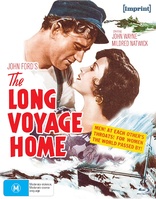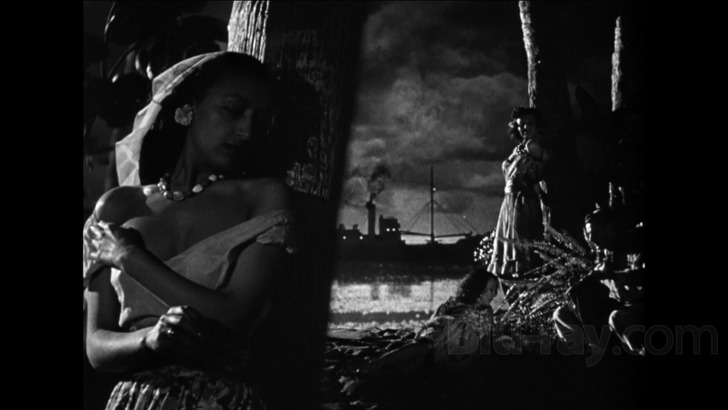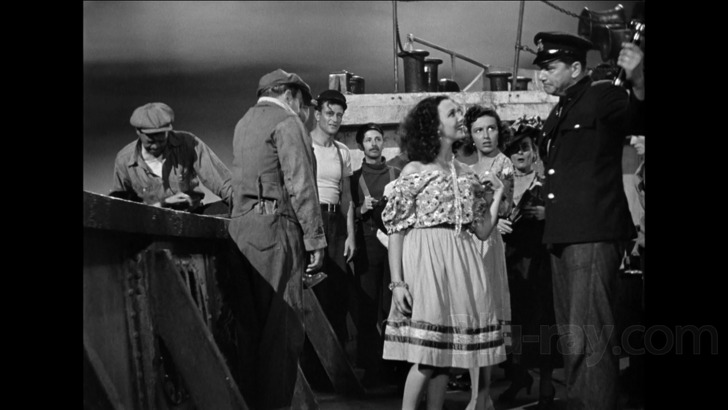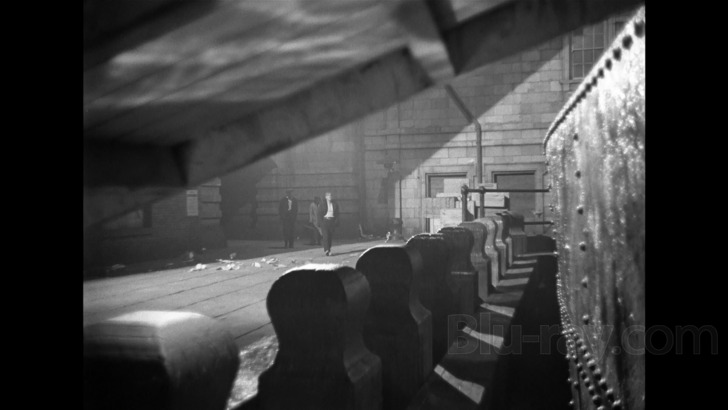The Long Voyage Home Blu-ray Movie
HomeThe Long Voyage Home Blu-ray Movie 
Limited Edition / ImportImprint | 1940 | 105 min | Rated ACB: M | Sep 15, 2023

Movie rating
6.6 | / 10 |
Blu-ray rating
| Users | 0.0 | |
| Reviewer | 4.5 | |
| Overall | 4.5 |
Overview
The Long Voyage Home (1940)
In 1940, the motley crew of the British tramp steamer SS Glencairn prepares the ship for its perilous voyage from the West Indies to Baltimore and then to England.
Starring: John Wayne, Thomas Mitchell (I), Ian Hunter (I), Barry Fitzgerald, Wilfrid LawsonDirector: John Ford
| War | Uncertain |
| Drama | Uncertain |
Specifications
Video
Video codec: MPEG-4 AVC
Video resolution: 1080p
Aspect ratio: 1.33:1
Original aspect ratio: 1.37:1
Audio
English: LPCM 2.0 Mono
Subtitles
English
Discs
Blu-ray Disc
Single disc (1 BD)
Playback
Region A (B, C untested)
Review
Rating summary
| Movie | 4.5 | |
| Video | 4.0 | |
| Audio | 3.0 | |
| Extras | 4.0 | |
| Overall | 4.5 |
The Long Voyage Home Blu-ray Movie Review
Reviewed by Justin Dekker September 10, 2024Legendary director John Ford's 1940 film "The Long Voyage Home" arrives on limited edition Blu-ray courtesy of Imprint. Lensed by Gregg Toland ('Grapes of Wrath', 'Citizen Kane') and based on four short plays penned by Nobel Prize winner Eugene O'Neill ('Long Day's Journey Into Night'), the film follows the men aboard the Glencairn as they take a load of ammunition to London in the early days of World War II. The moody and atmospheric film marks the second of Wayne's collaborations with Ford ('Stagecoach (1939)' was the first). Imprint's release features a 1080p presentation of the UCLA Film and Television Archive's restoration and a small assortment of high-quality supplemental features. It is housed in an attractive slipbox that features vintage artwork.

Within the first fifteen minutes and with an absolute minimum of dialogue, each of the significant themes Ford's film will explore over the remaining hour and forty-five minutes have been identified and established. Toland's carefully composed shots make the raw emotions and struggles of key characters manifest from the start. After a very brief look at the ship the Glencairn, home to the bulk of the film's events, in a tropical moonlit bay, the film cuts to a powerful and memorable process shot. Three beautiful women of the Caribbean languidly luxuriate on the shore: one close and leaning against a tree; another slightly further away lying among the ferns and other plants that carpet the beachfront area; and yet another who is slighter further still and is also reclining against a tree. All three are well dressed for the hot island climate, their white shirts riding off their shoulders and neatly tucked into flowing floral print skirts. Though only the woman who is lying down enjoys male companionship on this night with a large and bright but unseen moon, all three are clearly feeling amorous as they suggestively touch their exposed flesh in obvious wanton pleasure. Behind them, framed by the trees, the Glencairn sits anchored some fair distance away. Its shape and lights clearly distinguishable, but those who tread its decks cannot be seen from this vantage point.
However, as the scene cuts to the deck, we see Olsen (John Wayne) and several other members of the crew staring longingly and wordlessly at the shore. Even with the brightness of the moon, the men can't possibly make out any of the lusty women there, just out of reach, whose every motion seems to beckon with the promise of carnal pleasure. Are they even truly there? Or are they merely a figment of their imaginations borne of isolation, frustration, and unsatisfied want? The camera then makes its way further into the ship to the captain's quarters. The captain stands hunched over the radio as the signal strength fades in and out with reports of people being captured and ships exploding due to the punishing salvos of German anti-tank guns.
As a contemporary film set in the then-present day (1940), while the US had yet to enter the war, for many in Europe World War II was a stark reality. The news the radio spouts is clearly concerning and quickly casts a pall of despair, anxiety, and depression, over the entire ship, and suspicion and paranoia come with them. The ship, we learn, moments later, will be picking up ammunition. On the heels of this news, a boatload of prostitutes arrives on board, carrying baskets filled with fruit and alcohol, causing the sailors to spring to rowdy life as they quickly make their choices and drain the bottles.
Of equal importance and just before the viewer is met with those images, as the overture plays out, the words, "With their hates and desires men are changing the face of the earth - but they cannot change the Sea. Men who live on the Sea never change - for they live in a lonely world apart as they drift from one rusty tramp steamer to the next, forging the life-lines of Nations.", scroll across the screen. Over the course of the film, Dudley Nichols' screenplay based on O'Neill's work leverages the identified themes to support that mantra. For the men who crew the Glencairn, there is not a real ability or opportunity to change. Those who drink will continue to do so regardless of the cost. Those who are lonely may find temporary respite or distraction with prostitutes, but the underlying loneliness is never cured leading them to eventually give up on that pursuit. Death, when it finally arrives, underscores this, with few if any to notify of a man's passing. Even those who work hard to bankroll a future onshore find it virtually impossible to do so. They have the freedom of the sea but they are trapped on the ship. They are surrounded by mates (in terms of crewmen) but have no mates (in terms of spouses or partners). Wages are spent as quickly as they're earned to meet the basest of wants, with nothing left for anything else thereby leaving more important needs perpetually unfulfilled. While the cargo they carry may help to change the face of the earth, the Sea prevents, if not prohibits, most of the men of the Glencairn from ever changing. As the film draws to a close, those who slowly stride up the gangplank to the Glencairn deck do so with the gravity of condemned men walking to the gallows as they prepare to go to sea once more.
The Long Voyage Home Blu-ray Movie, Video Quality 

The Long Voyage Home's MPEG-4 AVC encoded 1080p transfer, is, for the most part very pleasing. Fine grain is omnipresent and resolves naturally, never becoming blotchy or noisy. Fine detail levels are typically quite good with environmental textures and particulars being discernable, especially above deck and in the bunks. Fine facial particulars are often on display, especially stubble and wrinkles on the faces of the crew. Blacks are beautifully deep and inky though crush can be an issue. There is some occasional softness in the image which may or may not have been a choice by Ford or Toland, but it's worth mentioning. There is also the very infrequent missing frame, odd bit of damage, and some image instability, but given the age of the film and this title not enjoying the same notoriety and stature of some of Ford's more well-loved and famous films that's not necessarily a surprise. Flickering also pops up from time to time, but while it is noticeable, it does not diminish the overall viewing experience.
The Long Voyage Home Blu-ray Movie, Audio Quality 

The Long Voyage Home comes equipped with a solid English LPCM 2.0 Mono track that is tasked with some difficult duties. The bulk of what the track needs to do is handle dialogue and it is quite capable in that regard. It is front and center-located and always properly prioritized. Sound effects are a taller order to fill but the track does so admirably. The storm at sea, even without support from the other speakers in my setup, is convincingly rendered with the whistling wind, pouring rain, and crashing waves dominating and burying all other sounds exactly as they should. The attack by from the German plane just past the film's halfway point is another sonic highlight. The loud whine of the engines, exploding bombs, and machine gun blasts are particularly powerful sonic elements for a film of this vintage, and though obviously not in the same league as more modern fare, they certainly exhibit sufficient realism and oompf. The wind and crashing waves during the funeral after one of the crew members passes away effectively furthers the sense of isolation felt by those aboard the Glencairn. As they huddle close together, their hats are pulled down and their collars are turned up with faces tucked into them to shield them from the elements. None can meet the gaze of another. The sound of the waves intermittently drowns out the captain's words as he officiates the solemn event. Though they stand shoulder to shoulder, they are completely cut off from one another and are unable to receive the comfort that the living expect to obtain from a funeral.
The Long Voyage Home Blu-ray Movie, Special Features and Extras 

- Audio Commentary by film historians Alain Silver and Jim Ursini (2023) - Silver and Ursini share this relaxed but highly interesting and informative commentary track. Never falling silent, the pair impart information about Wayne's character and history with Ford, Ford's personal life, elements frequently found in Ford's films, Toland's cinematography here and his overall body of work, among many other topics. It's free- flowing, sometimes keying in specifically on the on-screen action, and going off on semi-related tangents or deep-dives at others.
- University of Warwick film professor Josť Arroyo on 'The Long Voyage Home' (26.22) - Arroyo, who has an obvious love for the film, speaks about the themes of the film, shot composition, lighting, and the film's reputation.
- Cambridge University English professor Jean Chothia on Eugene O'Neill and 'The Long Voyage Home' (28.13) - Chothia discusses O'Neill's inspiration and his crafting of the four short plays that Dudley Nichols would adapt into the screenplay for The Long Voyage Home, beginning with their composition and first staging. She also covers how the elements from the plays were modified and re-sequenced for the film, O'Neill's ear for and focus on realistic dialogue, and a number of other topics.
- Homecoming: Video essay by Tag Gallagher, film critic and author of 'John Ford: The Man and his Films' (16.14) - As the feature begins to play, it is noticeable that it has a different title than what is listed on the packaging. Instead of Homecoming..., the title card names it as Going Home...John Ford's 'The Long Voyage Home'. The feature covers the origins of the film from four short plays by realist playwright Eugene O'Neill: The Moon of the Caribees, Bound East for Cardiff, In the Zone, and The Long Voyage Home and O'Neill's love for the finished film. He discusses the theatrical performance of the film, its atmosphere, bringing painters to the set to create powerful and evocative paintings of cast members and moments from the film which were then displayed in several museums, the film's cinematography and lighting, as well as themes, imagery, and symbolism.
The Long Voyage Home Blu-ray Movie, Overall Score and Recommendation 

Though John Wayne's Swedish accent may not quite be up to snuff, John Ford's The Long Voyage Home is a remarkably powerful, if bleak, film, that bears many of the director's trademarks and overall style. Gregg Toland's cinematography is inspired, filling the film with wonderfully layered, atmospheric, and melodramatic shots. The film may not enjoy the same status as Ford's films that came before and after it, but it is ripe for rediscovery courtesy of this very strong release from Imprint. Boasting a strong 1080p presentation, and a very satisfying audio track, fans of the film, Wayne, and Ford will no doubt be pleased. Dark, moody, surprisingly bawdy and erotic, and occasionally funny, Imprint's limited edition release of The Long Voyage Home is strongly recommended.
Similar titles
Similar titles you might also like
(Still not reliable for this title)

The Sea Chase
Warner Archive Collection
1955

The Bridges at Toko-Ri
1954

Action in the North Atlantic
1943

Mister Roberts
Warner Archive Collection
1955

The Cruel Sea
1953

The Caine Mutiny
1954

Midway
1976

Run Silent, Run Deep
Special Edition
1958

Greyhound
2020

Voyage of the Damned
1976

The Gallant Hours
1960

Morituri
Saboteur: Code Name Morituri | Limited Edition to 3000
1965

Eagles Over London
La Battaglia d'Inghilterra
1969

In Harm's Way
1965

Tobruk
1967

Ice Cold in Alex
1958

The Odessa File
1974

Operation Crossbow
The Great Spy Mission / Warner Archive Collection
1965

Wake Island
1942

Confessions of a Nazi Spy
Warner Archive Collection
1939